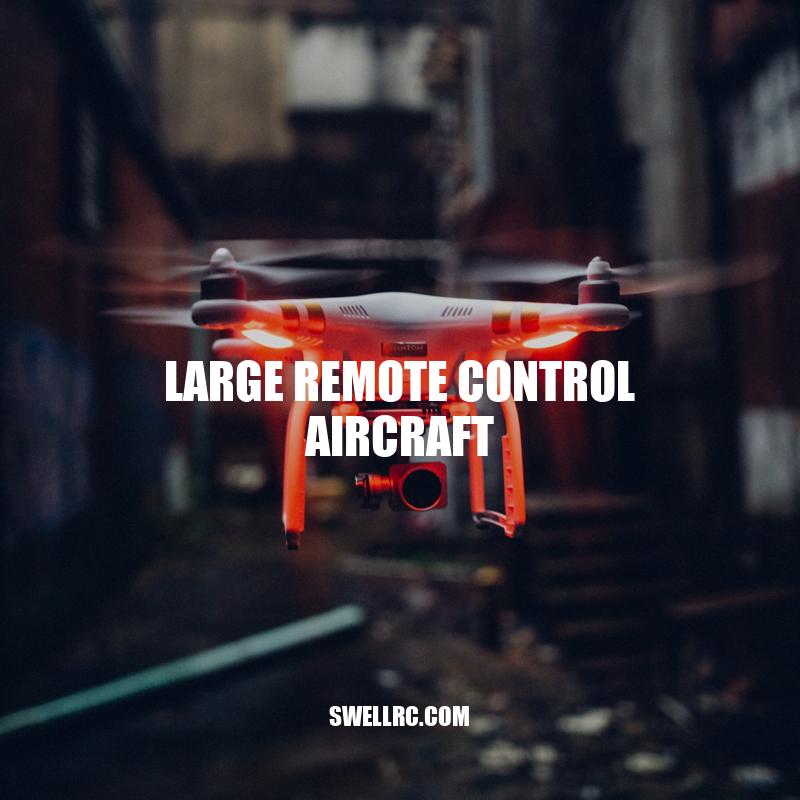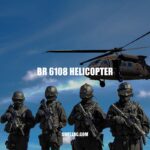Mastering Large Remote Control Aircraft: Benefits, Types, and Technical Specifications
Remote control aircraft have come a long way over the years, and their popularity has increased significantly in recent times. While smaller models of remote control aircraft have dominated the market, larger models have started to gain attention. Large remote control aircraft may seem daunting to the uninitiated, but they have many significant benefits, such as providing a more powerful and stable platform for aerial photography and for research purposes like land surveying or wildlife observation. Remote control aircraft can range in size from a few centimeters to several meters, with the larger models capable of carrying heavy payloads. However, despite their advantages, operating large remote control aircraft requires proper planning, training, and safety precautions. In this article, we will dive deeper into the world of large remote control aircraft, examining their benefits, key considerations, different types, technical specifications, and popular manufacturers.
Benefits of Large Remote Control Aircraft
Large remote control aircraft have many benefits that make them useful for a wide range of applications, some of which include:
- Photography: Large remote control aircraft provide a stable platform for aerial photography, allowing photographers to capture stunning images and videos from different perspectives. They can be used for filming movies, documentaries, and commercials, as well as for inspecting industrial sites and power lines. Popular models for aerial photography include the DJI Phantom series and the Yuneec Typhoon H.
- Research: Large remote control aircraft can be used for research purposes, such as studying wildlife, mapping, and surveying land. They provide a cost-effective and safe option to access areas that would otherwise be difficult or impossible to reach. Examples of research applications include the use of drones to track invasive plant species in forests or for monitoring oil spills in the ocean.
- Heavy lifting: Large remote control aircraft can carry a significant payload, making them useful for delivering goods and equipment, such as medical supplies, tools, and spare parts.
- Better control: Large remote control aircraft have advanced control systems that allow for more precise and stable flight, making them ideal for commercial applications such as crop dusting or firefighting.
Regardless of the intended use, operating large remote control aircraft comes with risks that need to be considered and managed carefully. In the next section, we will look at some of the factors to consider when operating large remote control aircraft.
What are the advantages of RC aircraft?
RC aircrafts have many advantages, including:
- Providing a fun and unique hobby for individuals of all ages.
- Improving hand-eye coordination and spatial awareness skills.
- Allowing pilots to experience the thrill of flight without leaving the ground.
- Providing opportunities for aerial photography and videography, especially with the use of drones.
- Being a valuable tool for education and training, such as pilots using RC aircrafts to simulate real-world scenarios.
- Offering a wide range of models to choose from, including helicopters, planes, gliders, and drones.
If you are interested in purchasing an RC aircraft or looking to learn more about this hobby, check out websites such as Horizon Hobby, Tower Hobbies, and RC Planet for a variety of options.
Factors to Consider When Operating Large Remote Control Aircraft
Operating large remote control aircraft requires careful consideration of various factors to ensure safety and regulatory compliance. Some of these factors include:
- Training: To operate a large remote control aircraft, you need to have proper training and certification from a recognized institution. This will ensure that you understand the technical and legal requirements of operating large remote control aircraft, as well as the risks involved.
- Regulations: Large remote control aircraft are subject to specific regulations that must be followed to ensure safety and compliance. These regulations may vary depending on the country or region in which you are operating the aircraft. For example, in the United States, large remote control aircraft must comply with the Federal Aviation Administration’s (FAA) rules for unmanned aircraft systems (UAS).
- Location: When operating large remote control aircraft, you need to consider the location and environment in which you are flying. This includes factors such as wind speed and direction, visibility, and obstacles or hazards in the area. It is important to select a safe and appropriate location for flying large remote control aircraft.
- Maintenance: Large remote control aircraft require regular maintenance to ensure safe and reliable operation. This includes checking and replacing components such as batteries, propellers, and motors, as well as inspecting the aircraft for damage or wear and tear.
- Risks: Operating large remote control aircraft comes with inherent risks, such as the possibility of accidents or damage to property. It is essential to have an emergency plan in place to manage these risks and to have adequate insurance coverage.
Table: Examples of Regulations for Large Remote Control Aircraft by Country
| Country | Regulations |
|---|---|
| United States | Federal Aviation Administration (FAA)‘s rules for unmanned aircraft systems (UAS), including registration and certification requirements. |
| Canada | Transport Canada’s rules for unmanned air vehicles (UAVs), including registration and certification requirements, and safety guidelines. |
| Australia | Civil Aviation Safety Authority (CASA)’s rules for remotely piloted aircraft systems (RPAS), including registration and certification requirements, and safety guidelines. |
By considering these factors and taking the necessary precautions, you can safely and effectively operate large remote control aircraft for a variety of applications. In the next section, we will look at different types of large remote control aircraft and the technical specifications to consider when selecting an aircraft.
Which of the following are safety guidelines for flying unmanned aircraft systems?
Safety guidelines for flying unmanned aircraft systems include:
- Always fly the drone below 400 feet above ground level
- Keep the drone in sight at all times
- Do not fly near other aircraft or airports
- Stay away from emergency response efforts such as fires or natural disasters
- Do not fly over people or private property without permission
- Check the FAA guidelines and regulations for drones
For more detailed guidelines, you can check the Federal Aviation Administration (FAA) website. They have a section specifically dedicated to flying unmanned aircraft systems. Additionally, if you are planning on purchasing a drone, many manufacturers include safety guidelines and recommendations with their products.
Different Types of Large Remote Control Aircraft
Large remote control aircraft come in different types, each with its unique features and applications. Some of the most common types of large remote control aircraft include:
- Fixed-wing aircraft: This type of aircraft has a wing structure that remains fixed in place, and relies on the forward motion to create lift. Fixed-wing aircraft are ideal for applications that require long flight times and high speeds, such as aerial photography and surveillance. Examples include the DJI Agras MG-1S and SenseFly eBee X.
- Rotary-wing aircraft: These aircraft have one or more main rotors that provide lift and propulsion. Rotary-wing aircraft are ideal for applications that require vertical takeoff and landing, hovering, and maneuvering in tight spaces. Examples include the DJI Matrice 600 and the Yuneec Typhoon H.
- Hybrid aircraft: These aircraft combine features of both fixed-wing and rotary-wing aircraft, allowing them to take off vertically like a helicopter and fly horizontally like a plane. Hybrid aircraft offer the advantages of both aircraft types and are ideal for applications such as search and rescue and inspection. Examples include the Xcraft X PlusOne and the MMC Hybrid.
When selecting a large remote control aircraft, it is important to consider the type that best suits your application and requirements. In the next section, we will discuss the technical specifications of large remote control aircraft and what to consider when selecting an aircraft.
What are remote controlled aircraft called?
Remote controlled aircraft are commonly known as drones or UAVs (unmanned aerial vehicles). Drones have become increasingly popular in recent years for recreational and commercial purposes. There are various types of drones available in the market, ranging from small and affordable models to advanced professional ones. Some popular brands that offer remote controlled aircraft include DJI, Parrot, and Yuneec. For more information on drones, you can visit websites like DroneRush or DroneDJ.
Technical Specifications of Large Remote Control Aircraft
When selecting a large remote control aircraft, it is important to consider the technical specifications that will meet your requirements. Some of the key technical specifications to consider include:
- Engine power: This determines the aircraft’s speed, lift capacity, and flight time. A high-powered engine is ideal for applications requiring high speeds and maneuverability, while a low-powered engine is ideal for long flight times and hover capability.
- Flight time: This is the length of time the aircraft can fly on a single battery charge. Longer flight times are ideal for applications that require extended time in the air, but may impact the aircraft’s weight and cost.
- Range: This is the maximum distance the aircraft can fly from the controller. A longer range is ideal for applications that require the aircraft to fly far from the operator, such as surveying and inspection.
- Camera and sensor payload capacity: This is the amount of weight the aircraft can carry in sensors and camera equipment. A higher payload capacity allows for more advanced equipment to be used.
Aircraft manufacturers typically provide these technical specifications for each of their models. It is important to review these specifications to ensure that the aircraft will meet the requirements of your application. In the next section, we will discuss popular manufacturers of large remote control aircraft and the differences between them.
What are the components of a remote control plane?
Remote control planes typically have the following components:
| Component | Description |
|---|---|
| Transmitter | A handheld device used to control the plane’s movements. |
| Receiver | Installed in the plane, receives signals from the transmitter and controls the plane’s servos. |
| Servos | Control the plane’s movements such as turning, accelerating, and decelerating. |
| Battery | Powers the receiver, servos, and motor. |
| Motor | Provides power to the propeller, which propels the plane forward. |
| Propeller | Provides the thrust needed for the plane to fly. |
There are many types of remote control planes available on the market, each with different specs and features. Some popular options include the E-flite UMX PT-17, the HobbyZone Carbon Cub S+ and the Flyzone Micro B-25 Mitchell. To learn more about the different components and options available for remote control planes, websites such as Horizon Hobby, Tower Hobbies, and Amazon offer a wide range of products and reviews.
Popular Manufacturers of Large Remote Control Aircraft
There are several manufacturers that offer large remote control aircraft. Some of the popular manufacturers include:
- DJI: DJI is a well-known manufacturer that offers a range of large remote control aircraft, including the Phantom and Inspire series. These aircraft are popular for aerial photography and videography, with high-quality cameras and sensors.
- Yuneec: Yuneec is another manufacturer that offers a range of large remote control aircraft, including the Typhoon and H520 series. These aircraft are popular for their durability and reliability in various applications, including surveying and inspection.
- Copter-Copter: Copter-Copter is a manufacturer that specializes in custom-built large remote control aircraft for research and scientific applications. Their aircraft are designed to carry specialized sensors and equipment for scientific research.
- Freefly Systems: Freefly Systems offers large remote control aircraft mainly for video and filmmaking applications, such as the Alta series. These aircraft are popular for the smooth and stable footage they can capture with specialized camera equipment.
Each of these manufacturers offers different features and capabilities with their aircraft. It is important to compare and contrast these features to find an aircraft that fits your specific needs. In the next section, we will discuss the differences between these manufacturers in more detail.
Which is the world biggest remote control Aeroplane?
The title for the “world’s biggest remote control airplane” is a coveted one, with several contenders vying for it. The current holder of the title, as of 2021, is the XC-142 tilt wing model created by Aviation Design.
Other notable contenders being:
- The Boeing 747-400 scale model, built and flown by the team at Aéro-Club de France in Paris.
- The Antonov AN-225 scale model, built by the Ukrainian modeling enthusiast Oleksandr Tereshchuk.
More information about these models can be found on their respective websites.
Conclusion
Overall, large remote control aircraft offer a range of benefits and applications in many industries. However, it is important to remember that operating these aircraft requires proper training and knowledge to ensure safe and effective use. When selecting a large remote control aircraft, it is important to consider factors such as technical specifications, intended use, and manufacturer options. By carefully considering these factors, you can ensure that you select an aircraft that is best suited to your needs and goals. Whether you are interested in using large remote control aircraft for photography, research, or surveillance, there are options available that can meet your needs within your budget. With the availability of large remote control aircraft, the sky truly is the limit in terms of capturing images, conducting research, and monitoring different environments.



